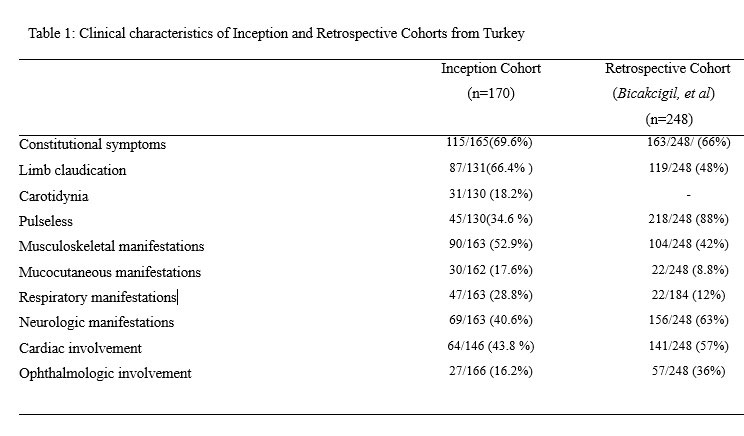Session Information
Session Type: Poster Session (Sunday)
Session Time: 9:00AM-11:00AM
Background/Purpose: There is only retrospective and very limited data for the long term prognosis of Takayasu’s Arteritis (TAK), a rare large-vessel vasculitis. In this study, we aimed to present the preliminary results of a Takayasu Inception Cohort settled for long term, prospective follow-up of only newly-diagnosed patients with TAK.
Methods: Patients fullfilling the American College of Rheumatology 1990 criteria for TAK and diagnosed in the last 12 months were included to the study. Patients’ data were recorded in an electronic database of an international “Takayasu’s Arteritis Registry” requiring baseline and at least annual visits. Data is compared with an historical Turkish cohort previously published (Bıçakçıgil, et al, 2009).
Results: The study included 170 patients (age: 38.5±13.1 years, F/M: 143/27) with TAK from 15 tertiary Rheumatology centers in Turkey. The mean symptom duration of patients was 5.2 years at diagnosis. According to the angiographic classification, 68.2% of the study group had type I and only 18.3% had type V disease. When we compared our results to our retrospective cohort (previously published by Turkish Takayasu Arteritis Study Group), constitutional symptoms (115/165= 69.6% vs 66%) and limb claudication (87/131= 66.4% vs 48%) were observed to be more frequent, whereas pulselessness (45/130=34.6 %vs 88%) was less in the inception cohort.(Table 1) Carotidynia was present only in the inception cohort. Similarly, mucocutaneous symptoms also seem to be a feature of newly-diagnosed disease (30/162=18.5% vs 8.8%). Regarding comorbidities at diagnosis, the rate of dyslipidemia was 17.6 (30/165)%, diabetes mellitus 15.1(25/165)%, smoking 20 (34/164)% and obesity ( BMI >30) 14 (22/157)% among TAK patients. All patients were given oral corticosteroid (CS) therapy (0.5-1 mg/kg) at diagnosis, 17 patients (17/170=10%) also having CS pulses. In addition to CSs, 86 patients (50.6 %) were given methotrexate, 31patients (18.2%) azathioprine, 6 (3.5%) cyclophosphomide, 12 patients (7.1%)leflunamide, 2(1.2%) patients mycophenolate mofetil and 5(2.9%) patients biologics at disease-onset(2 tocilizumab, 2 infliximab, 1 adalimumab). Biologic agents were chosen for 7 patients (7/32) at last vizit(1 adalimumab, 4 tosiluzumab, 2 infliximab). Seventy-three patients (42.9%) had follow-up > 3 months. Remission was observed 78% of patients. At least one relaps was observed 40% of these patients. Mortality rate was 4.1% ( 3/73 patients) during a mean 25.7 months follow-up.
Conclusion: Our results suggest that, in an inception cohort, signs and symptoms of ‘systemic inflammation’ is more prominent in newly-diagnosed TAK patients, whereas vascular extent and damage accumulates during the disease course. The long term follow-up of our inception cohort shows that 40% of patients relapse within 2 years after diagnosis in spite of IS treatments.
To cite this abstract in AMA style:
Alibaz-Oner F. Vascular Damage Is Less Present in an Early Inception Cohort in Takayasu’s Arteritis [abstract]. Arthritis Rheumatol. 2019; 71 (suppl 10). https://acrabstracts.org/abstract/vascular-damage-is-less-present-in-an-early-inception-cohort-in-takayasus-arteritis/. Accessed .« Back to 2019 ACR/ARP Annual Meeting
ACR Meeting Abstracts - https://acrabstracts.org/abstract/vascular-damage-is-less-present-in-an-early-inception-cohort-in-takayasus-arteritis/

